信息系统可行性研究包括很多方面内容, () 中经常会用到敏感性分析。
经济可行性分析主要是对整个项目投资及产生经济效益进行分析,具体包括:支出分析、收益分析、投资回报分析以及敏感性分析等。
试题一(共 20 分)阅读下列说明和图,回答问题 1 至问题 3,将解答填入答题纸对应栏内。【说明】设有二维整数数组(矩阵)A[1:m,1:n],其每行元素从左至右是递增,每列元素从上到下是递增。以下流程图旨在该矩阵中需找与给定整数 X 相等数。如果找不到则输出“false”;只要找到一个(可能有多个)就输出“True”以及该元素下标 i 和 j(注意数组元素下标从 1 开始)。例如,在如下矩阵中查找整数 8,则输出伟:True,4,12 4 6 94 5 9 106 7 10 128 9 11 13流程图中采用算法如下:从矩阵右上角元素开始,按照一定路线逐个取元素与给定整数 X 进行比较(必要时向左走一步或向下走一步取下一个元素),直到找到相等数或超出矩阵范围(找不到)。【流程图】

【问题】该算法时间复杂数是()
供选择答案:A.O(1) B.O(m+n) C.(m*n) D,O(m2+n2)
阅读以下说明和流程图,填补流程图中空缺,将解答填入答题纸对应栏内。
[说明]
指定网页中,某个关键词出现次数除以该网页长度称为该关键词在此网页中词频。对新闻类网页,存在一组公共关键词。因此,每个新闻网页都存在一组词频,称为该新闻网页特征向量。
设两个新闻网页特征向量分别为:甲(a1,a2,...,ak)、乙(b1,b2,...,bk),则计算这两个网页相似度时需要先计算它们内积S=a1b1+a2b2+...+akbk。一般情况下,新闻网页特征向量维数是巨大,但每个特征向量中非零元素却并不多。为了节省存储空间和计算时间,我们依次用特征向量中非零元素序号及相应词频值来简化特征向量。为此,我们用(NA(i),A(i)|i=1,2,...,m)和(NB(j),B(j)|j=1,2,...,n)来简化两个网页特征向量。其中:NA(i)从前到后描述了特征向量甲中非零元素A(i)序号(NA(1)<NA(2)<...),NB(j)从前到后描述了特征向量乙中非零元素B(j)序号(NB(1)<NB(2)<...)。
下面流程图描述了计算这两个特征向量内积S过程。
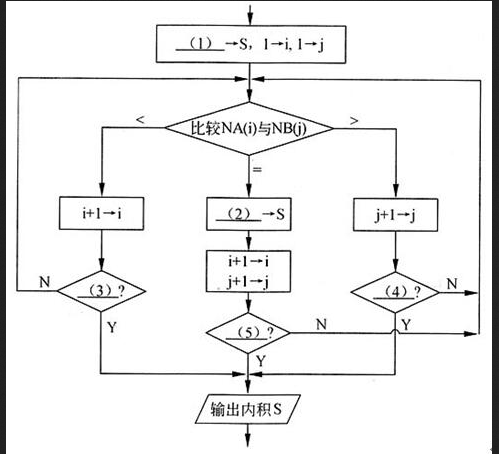
试题(15 分)阅读以下说明和流程图,填补流程图中空缺,将解答填入答题纸对应栏 内。【说明】设有整数数组 A[1:N](N>1),其元素有正有负。下面流程图在该数组 中寻找连续排列若干个元素,使其和达到最大值,并输出其起始下标 K、元素 个数 L 以及最大和值 M。例如,若数组元素依次为 3,-6,2,4,-2,3,-1,则输出 K=3,L=4,M=7。 该流程图中考察了 A[1:N]中所有从下标 i 到下标 j(j≥i)各元素之和 S,并动态地记录其最大值 M。【流程图】
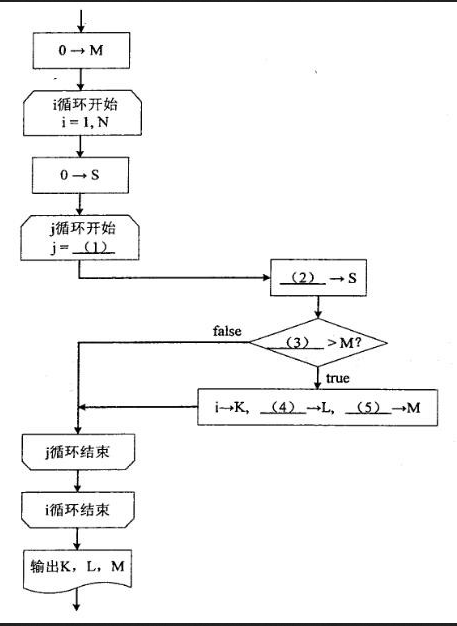
注:循环开始框内应给出循环控制变量初值和终值,默认递增值为 1,格式为:循环控制变量=初值,终值
阅读以下说明和流程图,填补流程图中空缺,将解答填入答题纸对应栏内。
[说明]
本流程图旨在统计一本电子书中各个关键词出现次数。假设已经对该书从头到尾依次分离出各个关键词{A(i)|i=1,…,n}(n>1)},其中包含了很多重复项,经下面流程处理后,从中挑选出所有不同关键词共m个{K(j)|j=1,…,m},而每个关键词K(j)出现次数为NK(j),j=1,…,m。
[流程图]
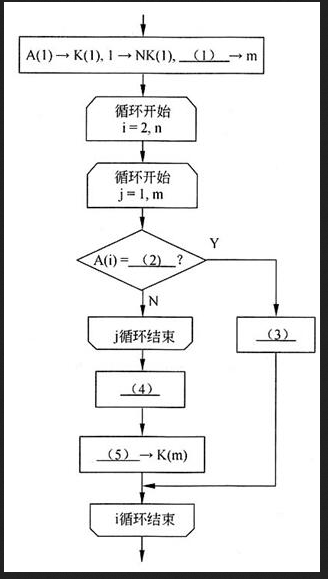
阅读下列说明、C++代码和运行结果,填补代码中空缺,将解答填入答题纸对应栏内。
[说明]
对部分乐器进行建模,其类图如下图所示,包括:乐器(Instrument)、管乐器(Wind)、打击乐器(Percussion)、弦乐器(Stringed)、木管乐器(Woodwind)、铜管乐器(Brass)。
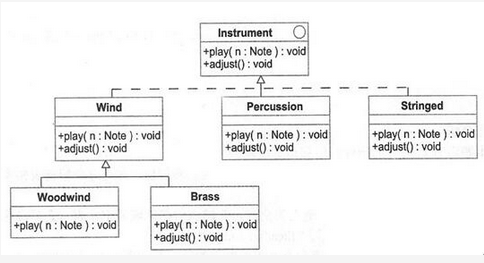
类图
下面是实现上述设计C++代码,其中音乐类(Music)使用各类乐器(Instrument)进行演奏和调音等操作。
using namespace std; enum Note(/*枚举各种音调*/ MIDDLE_C,C_SHARP,B_FLAT }; classInstrument{/*抽象基类,乐器*/ public: ______; //play函数接口 virtual voidadjust()=0; //adjust函数接口 }; class Wind ______{ public: void play(Note n) { cout<<"Wind.play() "<<n<<endl; } void adjust(){cout<<"Wind.adjust()"<<endl; } ); /*类Percussion和Stringed实现代码略*/ class Brass ______{ public: void play(Note n) {cout<<"Brass.play() "<<n<<endl; } void adjUSt(){cout<<"Brass.adjust()"<<endl;) }; classWoodwind:public Wind{ public: void play(Note n) { cout<<"Woodwind.play()"<<n<<endl; } }; class MusiC { public: voidtune(Instrument*i) { i->play(MIDDLE_C.; } voidadjust(Instrument*i){ i->adjust(); } void tuneAll(______ e[],int numIns){ /*为每个乐器定调*/ for(int i=0; i<numIns; i++){ this->tune(e[i]); this->adjust(e[i]); } } }; /*使用模板定义一个函数size,该函数将返回数组array元素个数,实现代码略*/ int main(){ Music*music=______ Music(); Instrument*orchestra[]={new Wind(),new Woodwind() }; music->tuneAll(orchestra,size(orchestra));/*size返回数组orchestra元素个数*/ for(int i=0;i<size(orchestra);i++) deleteorchestra[i]; delete music; }
本程序运行后输出结果为:
Wind.play()0 Wind.adjust() Woodwind.play()0 Wind.adjust()
第五题 阅读以下说明和Java代码,填补代码中空缺,将解答填入答题纸对应栏内。
【说明】
以下Java代码实现一个超市简单销售系统中部分功能,顾客选择图书等物件 (Item)加入购物车(ShoppingCart),到收银台(Cashier)对每个购物车中物品统计其价格进行结账。设计如图5-1所示类图。
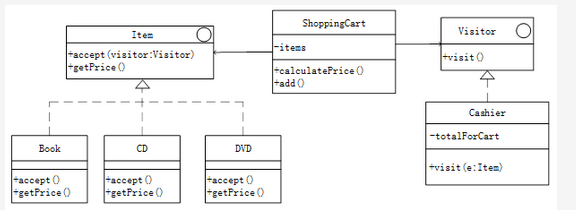
问题:5.1 【Java代码】
interface Item{
public void accept(Visitor visitor);
public double getPrice();
}
class Book (1){
private double price;
public Book(double price){(2);}
public void accept(Visitor visitor){ //访问本元素
(3);
}
public double getPrice() {
return price;
}
}
//其它物品类略
interface Visitor {
public void visit(Book book);
//其它物品visit方法
}
class Cashier(4){
private double totalForCart;
//访问Book类型对象价格并累加
(5){
//假设Book类型物品价格超过10元打8折
if(book.getPrice()<10.0){
totalForCart+=book.getPrice();
} else
totalForCart+=book.getPrice()*0.8;
}
//其它visit方法和折扣策略类似,此处略
public double getTotal() {
return totalForCart;
}
}
class ShoppingCart {
//normal shopping cart stuff
private java.util.ArrayList<Item>items=new java.util.ArrayList<>();
public double calculatePrice() {
Cashier visitor=new Cashier();
for(Item item:items) {
(6);
}
double total=visitor.getTotal();
return total;
}
public void add(Item e) {
this.items.add(e);
}
}
【试题三】阅读下列说明和 C 函数,填补 C 函数中空缺,将解答填入答案纸对应栏目内。【说明】字符串是程序中常见一种处理对象,在字符串中进行子串定位、插入和删除是常见运算。设存储字符串时不设置结束标志,而是另行说明串长度,因此串类型定义如下:Typedef struct ﹛char*str //字符串存储空间起始地址int length //字符串长int capacity //存储空间容量﹜SString;【函数 1 说明】函数 indexStr(S,T,pos)功能是:在 S 所表示字符串中,从下标 pos 开始查找 T 所表示字符串首次出现位置。方法是:第一趟从 S 中下标为 pos、T 中下标伟 0 字符开始,从左往右逐个对于来比较 S 和 T 字符,直到遇到不同字符或者到达 T 末尾。若到达 T 末尾,则本趟匹配起始下标 pos 为 T 出现位置,结束查找;若遇到了不同字符,则本趟匹配失效。下一趟从 S 中下标 pos+1 处字符开始,重复以上过程。若在 S 中找到 T,则返回其首次出现位置,否则返回-1。例如,若 S 中字符串伟″students ents″,T 中字符串伟″ent″,pos=0,则 T 在 S 中首次出现位置为 4。【C 函数 1】int indexStr(SString S ,SString T,int pos)﹛int i,j:if(S.length<1||S.length<pos+T.length-1)return-1;for(i=pos,j=0;i<S.length &&j<T.length;)﹛if (S.str[i]==T.str[j])﹛i++;j++;﹜else﹛i=();j=0﹜﹜if ()return i -T.length;return-1;﹜【函数 2 说明】函数 eraseS 位(S,T}功能是删除字符串 S 中所有与 T 相同子串,其处理过程为: 首先从字符串 S 第一个字符(下标为 0)开始查找子串 T,若找到〈得到子串 在 S 中起始位置),则将串 S中子串 T 之后所有字符向前移动,将子串 T 覆盖,从而将 其删除,然后重新开始查找下一个子串 T,若找到就用后面宇符序列进行覆盖,重复上述过程,直到将 S 中所有子串 T 删除。例如,若字符串 S 为 “12ab345abab678”、T 为“ab”。第一次找到 "ab" 时(位置为(2),将 "345abab678 "前移,S 中串改为"12345abab678" ,第二次找到"ab"时(位置为 5);将 ab678 前移,S 中串改为 "12345ab678",第三次找到"ab"时(位置 为 5);将“678‘前移 ,S 中串改为 "12345678 "。【C 函数 2】void eraseStr(SString*S,SStringT)﹛int i;int pos;if (S->leght<1||T.length<1||S->length<T.length)return;pos=0for(;;)﹛//调用 indexStr 在 S 所表示串 pos 开始查找 T 位置pos=indexStr();if(pos==-1) //S 所表示串中不存在子串 Treturn;for(i=pos+T.length;i<S->length;i++) //通过覆盖来删除自串 TS->str[()]=S->str[i];S->length=(); //更新 S所表示串长度﹜﹜
阅读以下说明和C程序,填充程序中空缺,将解答填入答题纸对应栏内。
[说明]
正整数n若是其平方数尾部,则称n为同构数。例如,6是其平方数36尾部,76是其平方数5776尾部,6与76都是同构数。下面程序求解不超过10000所有同构数。
已知一位同构数有三个:1,5,6,因此二位同构数个位数字只可能是1,5,6这三个数字。依此类推,更高位数同构数个位数字也只可能是1,5,6这三个数字。
下面程序处理思路是:对不超过10000每一个整数a,判断其个位数字,若为1、5或6,则将a转换为字符串as,然后对a进行平方运算,并截取其尾部与as长度相等若干字符形成字符串后与as比较,根据它们相等与否来断定a是否为同构数。
[C程序] #include<stdio.h> #include<stdlib.h> #include<string.h> int myitoa(int,char*); /*将整数转换为字符串*/ /*right取得指定字符串尾部长度为length子串,返回所得孔串首字符指针*/ char*right(char*,int length); int main() { int a,t; int fen; char as[10],rs[20]; printf("[1,10000]内同构数:\n"); for(a=1; a<=10000;a++) { t=______; /*取整数a个位数字*/ if(t!=1&&t!=5&&t!=6)continue; len=myitoa(a,as); /*数a转换为字符串,存入as*/ myitoa(a*a,rs); /*数a平方转换为字符串,存入rs*/ /*比较字符串as与rs末尾长度为len子串是否相等*/ if(strcmp(as,______)==0) /*若相同则是同构数并输出*/ printf("%s平方为%s\n",as,rs); } return 0; } int myitoa(int num,char*s) /*将整数num转换为字符串存入s*/ { int i,n=0; char ch; /*从个位数开始,取num每一位数字转换为字符后放入s[]*/ while(num){ s[n++]=______+'0'; num=num/10; } s[n]='\0'; for(i=0; i<n/2;i++){ /*将S中字符串逆置*/ ______;s[i]=s[n-i-1]; s[n-i-1]=ch; } return n; /*返回输入参数num位数*/ } char*right(char*ms,int length) /*取字符串ms尾部长度为length孔串,返回所得孔串首字符指针*/ { int i; for(;*ms;ms++); /*使ms到达原字符串尾部*/ for(i=0;i<length;______); /*使ms指向所得孔串首部字符*/ return ms; }
试题六(共 15 分)阅读下列说明和 C++代码,填补代码中空缺,将解答填入答题纸对应栏内。【说明】以下 C++代码实现一个简单客户关系管理系统(CrM)中通过工厂(Customerfactory)对象来创建客户(Customer)对象功能。客户分为创建成功客户(realCustomer)和空客户(NullCustomer)。空客户对象是当不满足特定条件时创建或获取对象。类间关系如图6-1 所示。
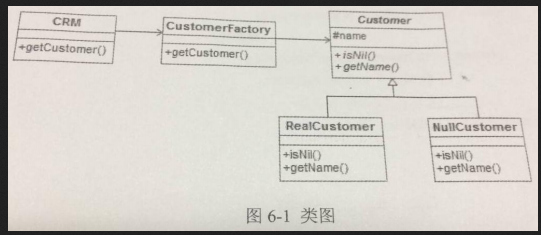
【C++代码】#include<iostream>#include<string>using namespace std; class Customer{protected:string name;public:(1) boll isNil()=0;(2) string getName()=0;﹜; class realCustomer (3){public:realCustomer(string name){this->name=name;﹜bool isNil(){ return false;﹜string getName(){ return name;﹜﹜; class NullCustomer (4) {public:bool isNil(){ return true;﹜string getName(){ return 〝Not Available in Customer Database〞; ﹜﹜;class Customerfactory{public:string names[3]={〝rob〞, 〝Joe〞,〝Julie〞﹜;public:Customer*getCustomer(string name){for (int i=0;i<3;i++){if (names[i].(5) ){return new realCustomer(name);﹜﹜return (6);﹜﹜; class CrM{public:void getCustomer(){Customerfactory*(7);Customer*customer1=cf->getCustomer(〝rob〞);Customer*customer2=cf->getCustomer(〝Bob〞);Customer*customer3=cf->getCustomer(〝Julie〞);Customer*customer4=cf->getCustomer(〝Laura〞); cout<<〝Customers〞<<endl;cout<<Customer1->getName() <<endl; delete customer1;cout<<Customer2->getName() <<endl; delete customer2;cout<<Customer3->getName() <<endl; delete customer3;cout<<Customer4->getName() <<endl; delete customer4;delete cf;﹜﹜; int main(){CrM*crs=new CrM();crs->getCustomer();delete crs;return 0;﹜ /*程序输出为:CustomersrobNot Available in Customer DatabaseJulieNot Available in Customer Database*/
第三题 阅读以下代码和问题,回答问题1至问题3,将解答填入答题纸对应栏内。
【代码 1】
typedef enum {A,B,C,D} EnumType;
EnumType f(int yr)
{
if(0 == yr%400) {
return A;
}
else if (!(yr%4)) {
if(0!=yr%100)
return B;
else
return C;
}
return D;
}
【代码2 】
#include<stdio.h>
int main()
{ int score;
scanf("%d",&score);
switch (score)
{
case 5: printf("Excellent!\n");
case 4: printf("Good!\n"); break;
case 3: printf("Average!\n");
case 2:
case 1:
case 0: printf("Poor!\n");
default: printf("Oops,Error\n");
}
return 0;
}
【代码3】
#include<stdio.h>
int main()
{ int i,j,k;
for(i=0; i<2; i++)
for(j=0; j<3;j++)
for( k=0; k<2;k++) {
if(i!=j&&j!=k)
printf("%d %d %d\n", i,j,k);
}
ruturn 0;
} 问题:3.1 (4分)
对于代码1,写出下面函数调用后x1 、x2、x3和x4值。
x1 = f(1997);
x2 = f(2000);
x3 = f(2100);
x4 = f(2020); 问题:3.2 (5分)
(1)写出代码2进行时输入为3输出结果;
(2)写出代码2进行时输入为5输出结果。 问题:3.3 (6分)
写出代码3运行后输出结果。